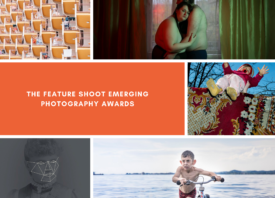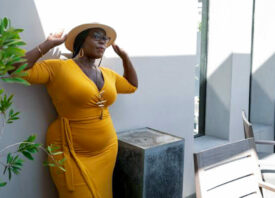Search this site
Emerging Photography Awards Juror Lauri Lyons Looks Back on 20 Years in the Industry


It’s been more than two decades since Lauri Lyons traversed the United States, meeting people and asking them about their feelings about our country. She photographed each of them holding the American flag, traveling from place to place by train, and stopping in youth hostels along the way. She met parents, children, missionaries, former gang members, police officers, and more. Her book Flag: An American Story was released in 2001. American identity is a theme she’d refer to again and again throughout her career, as a documentary photographer, journalist, and author.
This year, Lyons is one of our judges for the Feature Shoot Emerging Photography Awards, where she will be joined by twenty-three industry leaders, from photo editors to curators. We recently had a chance to catch up with her over email. As part of the 7th annual awards, twelve photographers will be chosen to have their series exhibited at BBA Gallery in Berlin and Studio Galerie B&B in Paris 60 single-image winners will be part of a street exhibition in Los Angeles and New York. Learn more about the awards, including how to submit, by visiting our website.
You’re the author of Flag: An American Story, the culmination of five years spent traveling throughout the United States, meeting and photographing citizens and learning their stories. Today, is there any specific person or conversation you find yourself returning to over and over again?
“The conversation that really sparked the Flag series took place in Minneapolis. I met a young mother, approximately 30 years old, and her daughter, who was 12 years old. The daughter wanted to write her thoughts about America and asked her mother how to spell the word ‘beautiful.’ The mother looked at me, and I spelled ‘beautiful.’ The daughter then asked her mother how to spell ‘America.’ Again, the mother looked at me and I spelled ‘America.’
“Both the mother and daughter were born and raised in America, and the daughter attended school daily. It was at that moment I realized I needed to take a deeper dive into what was brewing beneath the surface of the American Dream and begin traveling around the country to interview people. While on the road, I met so many children who wrote about gun violence in their neighborhood. Their comments were foreboding messages about the school shootings and mass shooting epidemic in this country, which has unfortunately become routine.
How has your relationship with this book changed over time?
“On a personal note, I now realize the exploration of America was also a subconscious exploration of my own identity and experiences in America. The Flag books have a life of their own and are more relevant today than they were 20 years ago. As time has passed, I consider the books to be a creative foundation from which I learned to engage and investigate the world.”

You are also the photographer for INSPIRATION: Profiles of Black Women Changing Our World. Can you tell us about one of the women you met for the book?
“I photographed 30 women for the INSPIRATION book. I had the honor of meeting and befriending Dr. Patricia Bath, a world-renowned ophthalmologist and inventor Dr. Bath was truly a genius. Her groundbreaking invention of laser cataract surgery and her five invention patents, including the Laserphaco Probe, enabled millions of people around the world to regain their vision. I had the pleasure of photographing her inside her Los Angeles home and later spending personal time with her whenever she visited New York. She was a phenomenal woman in every respect.”

You’re the Founding Executive Director of the not-for-profit organization Rest With Honor. In that role, you’ve worked tirelessly to protect an unmarked burial ground in Savannah, which from 1763 to 1850 was the only place where Black people were legally allowed to be buried. Can you tell us a bit about the project?
“The story behind Rest with Honor Savannah began in 2017 when I participated in a press trip to Georgia. During the trip, I attended a walking ghost tour of Savannah. One of the locations on the tour was Calhoun Square, which the tour guide mentioned was rumored to once have been an African burial ground. I later began researching the area to find out if the rumor was true or false.
“After performing extensive research, I learned the Negro Burying Ground aka African burial ground did exist in and around that area. The burial ground remained unmarked and officially unrecognized by the City of Savannah. Unfortunately, the burial ground area has been named after a Confederate icon (John C. Calhoun) and a pro-slavery advocate (Reverend Geroge Whitefield) since 1850.
“In 2020, I launched the Rest With Honor Savannah initiative to commemorate, protect, memorialize, and rename the burial ground area. Researching the burial ground included digging deep into municipal archives, image banks, newspaper archives, and interviewing historians and scientists. The project requires a mixture of historical research, intuition, and detective work.”

What inspired you to create Nomads Magazine, where you currently serve as Editor-in-Chief? Can you tell us about some of the most inspiring or exciting stories you’ve worked on for the magazine?
“Nomads was sparked by the desire to create a platform for artists behind the scenes–on-the-road artist stories. I knew so many artists that would tell these incredible travel stories, if you ran into them. Otherwise, the stories disappeared into the ether because it was not the focus of their project.
“We have been very fortunate to be able to showcase large feature stories by a wide array of artists and journalists. Some of my personal favorite photo stories were Young Turks by John-Paul Pietrus, Pow-Pow by Phillip Englehorn, Chasing Ice by James Balog, Baghdad Journal by Steve Mumford, Stormy Monday by Gerald Cyrus, and Still Alive by Scarlett Cotten.
“These stories covered couture fashion shot on the streets of Istanbul, the changing glacial environment, an artist’s diary of being embedded with a military platoon in Iraq, Harlem jazz clubs, China’s head-to-toe bathing suits, and Egyptian nomadic families.”

You’ve taught at the International Center of Photography, the Rhode Island School of Design, and the New School for Social Research. What advice would you give to today’s emerging photographers, and what kind of work will you be looking for when judging the Feature Shoot Emerging Photography Awards?
“The best advice I could give an emerging photographer is to conceptualize a course for your long-term career. Think about how you would like to grow and evolve: creatively, intellectually, professionally, and financially. Get advice from older, established artists. The photography industry and media technology are shifting so quickly; you need to think about how you can be versatile in your approach, but grounded in your skills and goals.
“For the Feature Shoot Emerging Photography Awards, I will be looking for fresh visual perspectives that get me excited about what I am looking at and make me wish I took the photo or was there when it happened.”
The deadline for the Feature Shoot Emerging Photography Awards is September 3rd, 2021. Submit your work today!


